How to Identify and Remove Poison Hemlock
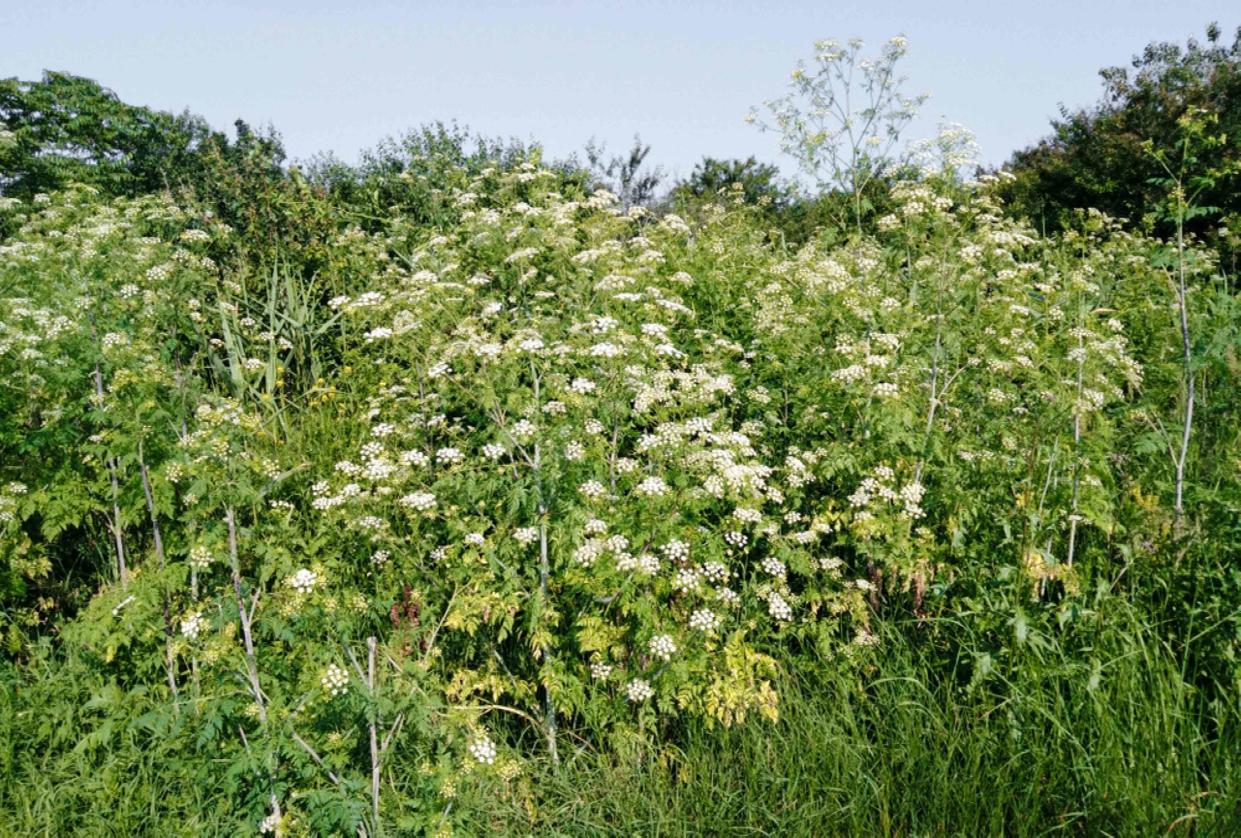
The Spruce / K. Dave
Reviewed by Amanda Rose Newton
Poison hemlock (Conium maculatum) is a biennial plant native to Europe and North Africa. It was introduced to the United States as an ornamental garden plant in the 1800s despite being highly toxic to humans and animals. Over time, poison hemlock has naturalized in almost every state; it is classified as an invasive plant.
Poison hemlock not only takes over roadsides, ditches, pastured, and meadows, it can also find its way into your yard. As a member of the carrot family (Apiaceae), poison hemlock has several look-alikes. Learn how to identify this noxious and toxic weed and get rid of it safely.
Which Parts of Poison Hemlock Are Toxic?
All parts of the poison hemlock—leaves, flowers, seeds, stems, and roots—are highly toxic. Merely touching it or brushing up against accidentally causes severe, long-lasting injury.
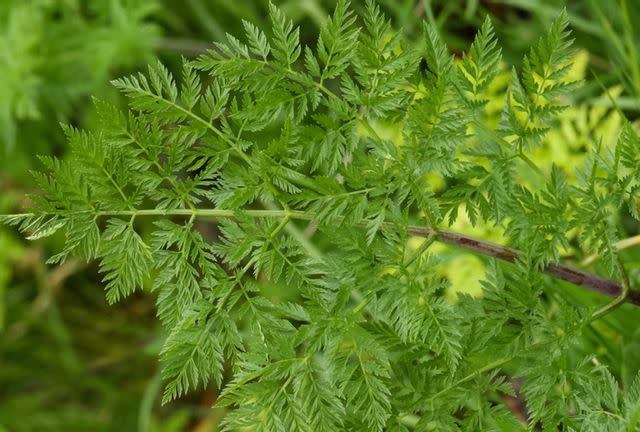
The Spruce / K. Dave
How to Identify Poison Hemlock
The plant changes in appearance during its two-year life cycle and every stage offers clear indicators for its identification. Keep in mind to practice utmost caution when looking at the plant for identification and abstain from getting too close or touching it without proper protective gear.
In the first year, poison hemlock grows in a large rosette of basal leaves up to 2 feet long. The dark-green leaves are alternate, mostly triangular, lacy, and deeply divided. The leaves and stems are hairless.
In the spring of its second year, after the plant emerges from its winter dormancy, poison hemlock develops branching and grows a tall flowering stalk up to 8 to 10 feet in height. The stem is sturdy yet hollow. It might appear ridged because of it veins. A telltale characteristic of the plant are the purple blotches or spots on the stem. The leaves on the upper part of the stem are not as large as the basal leaves.
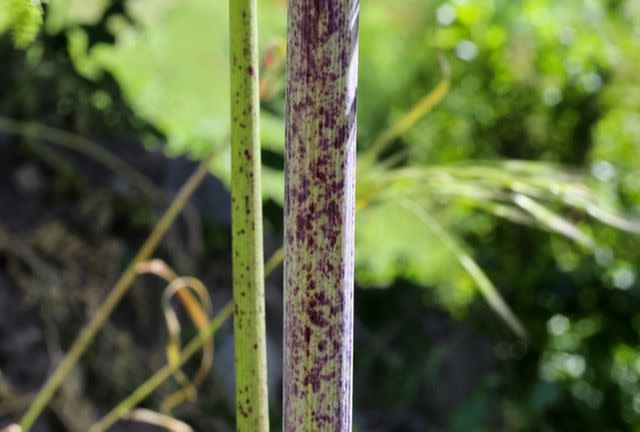
The Spruce / K. Dave
The bloom time of poison hemlock can vary greatly from one year to another as it depends on weather conditions. Between May and August, white flower clusters, either flat-topped or slightly convex like an umbrella, appear on the end of the stalks. The clusters are 2 to 3 inches in diameter and each flower consist of five small petals.
After the plant sets seeds, it dies. The stems with the seed capsules, each containing two round and ribbed seeds, remain on the plant. The seed capsule splits and releases the seed when mature.
Plants That Look Similar to Poison Hemlock
There are non-toxic native plants, toxic native plants, and invasive toxic plants that at first glance look similar to poison hemlock. Most of them, however, have distinct features that set them apart.
Angelica (Angelica atropurpurea) shares purple stems with poison hemlock. The leaves are compound and sharply toothed, not lacy.
American elderberry (Sambucus canadensis) also has white flowers that are much larger than those of poison hemlock. Elderberry has oblong, sharply serrated leaves and woody stems without any purple spots.
Common ragweed (Ambrosia artemisiifolia) has very lacy leaves, but the stems are hairy. The inconspicuous green flowers in the late summer are located at the end of the branches.
Common yarrow (Achillea millefolium) leaves are feathery and fern-like and the plant is much smaller, about 3 feet.
Tall meadow rue (Thalictrum dasycarpum) can have purple spots on green stems. The leaves are lobed and not lacy.
Cow parsnip (Heracleum lanatum) is as tall as poison hemlock and also toxic. Its flower head is distinctly different, much larger and up to 1 foot across. The stem is green without any purple spots and the deeply lobed leaves are much larger than poison hemlock.
Spotted water hemlock (Cicuta maculata) and western water hemlock (Cicuta douglasii) are two related native species that are both highly toxic, just as poison hemlock. While it might take a trained eye to distinguish the flowers–umbels of small white flowers on tall stems that can reach up to 6 feet in height—from those of poison hemlock the stems are different. The stems of water hemlock are pale green with purple stripes, which distinguishes them from the spotted or blotchy stems of the poison hemlock. The location can also give you cues, as water hemlock grows primarily in wet locations such as ditches, stream banks, pond margins, and marshes.
Giant hogweed (Heracleum mantegazzianum) grows much taller than poison hemlock, up to 15 to 20 feet in height, and it is just as invasive and toxic. The stems may have purple spots like poison hemlock but the leaves look different, they are deeply incised and not lacy.
Queen Anne’s Lace (Daucus carota) is often confused with poison hemlock because of its lacy leaves. The stem of Queen Anne’s lace, however, is hairy and it does not have purple blotches. Also, Queen Anne’s lace has lacy bracts under the white flower heads. The plant is also toxic.
Wild parsnip (Pastinaca sativa) is a tall plant that you should never touch because it’s so toxic. The similarities with poison hemlock end here. Wild parsnip can be distinguished by its celery-like leaves and yellow flowers. The stems do not have purple blotches.
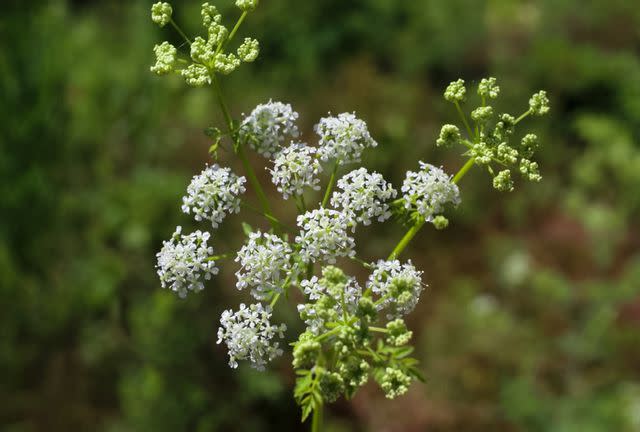
The Spruce / K. Dave
Closeup of a poison hemlock flower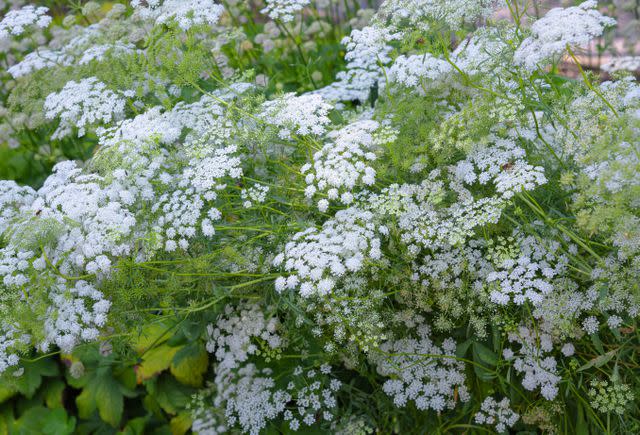
The Spruce / Evgeniya Vlasova
Closeup of Queen Anne's lace flowersWhere Does Poison Hemlock Grow
Poison hemlock grows in full sun to light shade. While it prefers moist soil, it is otherwise not finicky about its location. As a so-called “pioneer species” it quickly populates disturbed sites such as cleared woodlands. It grows along roadsides, along farm fields, in ditches, marshes, and meadows.
Poison hemlock spreads via seeds (up to 30,000) that drop near the plant. Seeds are also dispersed through wildlife and water.
How to Get Rid of Poison Hemlock
Removing poison hemlock depends on the age of the plant and the level of infestation. Wearing protective clothing (long sleeves) and avoiding any bare-skin physical with the plant is a must no matter how small or big the infestation.
Small first-year seedlings can be removed by hand. After a rain when the soil is moist is best to remove the entire tap root. You might have to use a trowel or a shovel if the rosette is already big.
If you are dealing with a heavy infestation and a large area, mowing the infestation repeatedly helps to weaken the plants. Mowing must be done in the early summer before the plant has set seeds, otherwise you are dispersing the seeds even more. Mowing in the late summer after poison hemlock has gone into see also poses a greater health hazard.
If you cannot get the infestation under control manually, it is best to use a broad-spectrum herbicide in the first year of the plant’s life cycle. Keep in mind that it will also kill all the other plants so apply it in a highly targeted way and when there is no wind to avoid herbicide drift. Applying an herbicide does not prevent seeds that are already in the soil from germinating (poison hemlock seeds remain viable for up to six years) so you will likely have to repeat the herbicide application when new seedlings emerge.
Any pulled plants as well as seed heads should be disposed of in the garbage; do not compost them, as the composting process does not eliminate the toxins. Also do not burn any plant residue, which releases the toxins in the air.
Eradicating a severe poison hemlock infestation takes persistence and several growing seasons, and possibly a combination of manual and chemical methods. After you have fully cleared an area, replant it promptly with desirable, preferably native plants, to prevent poison hemlock from reestablishing itself.
Text Link:The 11 Best Weed Killers of 2023

